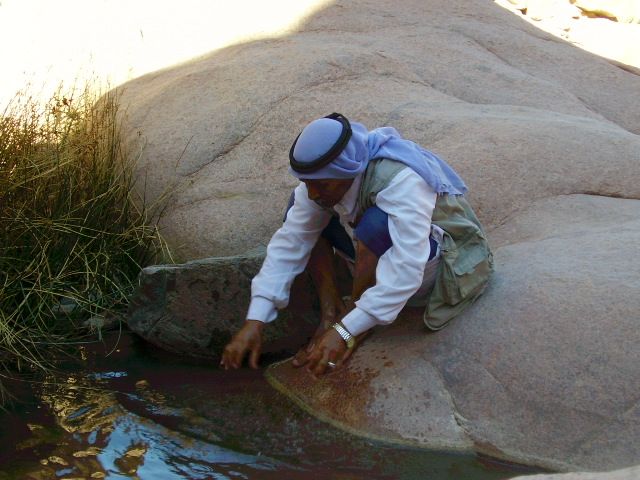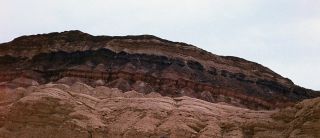|
The Eco Lodge is located in the St. Katherine's Protectorate (4300 km2). This protectorate intends to maintain the natural and cultural features of this region, while the local Bedouin follow their traditional lifestyle, so as a visitor you can experience here what is so unique about this place.
This vast landscape is formed about 600 million years ago and this makes the Sinai Mountains one of the oldest massifs in the world. Apart from the red granite rocks that occupy 80% of the Sinai Mountains, there are also newer (10 million years old) black volcanic rock formations.
The labyrinth of interconnected valleys (wadis) was created by rainfall and melting snow resulting in huge rocks sown down by the tremendous force of the water.
You find a great biological diversity in this area.
It is home to two thirds of all butterflies in Egypt and the Sinai is known for its many different types of (medicinal) plants: 1262 of which 520 species are native to Egypt and 36 only grow in Saint Katherine's Protectorate. Many native plants are now endangered species.
The ancient knowledge of the Hakims (Bedouin doctors/healers) was threatened to be lost, but thanks to a local project this unique knowledge can now be transferred to new generations. They try to sign over the intellectual rights to the local Uzbeliya Bedouin tribe.
Fom April to July you can find here the Sinai Button Blue, the smallest butterfly in the world. The adult butterflies are not such good flyers and they rumble mainly around large thyme bushes. This butterfly was discovered here in 1974 and it is unique in the world. Its continued existence is now endangered by global warming.
If you're in the mountains (away from the pilgrims, tourists and photographers) you really start to understand the beauty of this area. The wadi's are filled with fragrant herbs and plants that grow nowhere else and fill the fresh mountain air. This botanical diversity is due to the location of the Sinai (between Africa, the Middle East and Europe) and the amount of rainfall.
In winter, the peaks are covered with snow and melt water remains underground during the long dry periods in spring, summer and autumn.
There are 40 species of butterflies and many other animals such as the Nubian ibex, the Hyrax, the red fox, the dormice, the spiny mouse, the hyena, the wolf and the Sinai Agama lizard.
The Sinai desert has very low annual rainfall but once in so many years there’s a deluge of Biblical proportions from the mountains. The last time this happened was in January 2010. These enormous floods rumble down, and channel and shape the landscape.
The view from the highest mountains in Sinai is spectacular and there are many more wonderful places to be found in the wadi’s. There are wells, creeks, ponds (water in which you can safely swim), narrow canyons, steep wadis with large boulders, amazing rock formations and valleys with rich vegetation.
The highest mountain of Egypt is Mount Sinai (Mount Moses, Gebel Katherine, Gebel Moussa) but there are many other high peaks above 2000 meter altitude nearby, such as Gebel Abbas Pasha, Umm Shomar, El Bab, Tarbush and Bab El Donya from which you can see the Gulf of Suez and El Tur and under the top is the well of Ain Nagila.
A little further away you find the mountains Gebel Ahmar, Sirbel, Banat and Sana. These are more accessible from Wadi Feiran.
There are permanent water pools on top of Wadi Shag Tinya, the Kharazet El Shag, in a dramatic setting. The water of Wadi Tinya drops down in a granite basin and then flows into the other pools to a deep wadi. In some places it flows under the rocks and at other places it comes back to the surface. The water is clean and drinkable in the upper pool.

At the beginning of Wadi Shag is a narrow canyon where you find standing granite water ponds. In Wadi Tubug the water falls from the rocks in a double fountain. The lowest fountain is for the animals and the local people drink from of the highest fountain. There is also a more than 1000 years old mulberry tree which is protected by the law of the local Bedouin tribes.
From Wadi Tubug you descend to Sid Da'ud: a close and steep narrow path through the cave under large boulders runs.
Geology
The South Sinai massif is a part of the Arabian-Nubian massif and consists mainly of chilled magma which welled up.
It is classified into 3 types:
1. Plutonic granite was formed beneath the operating surface and cooled slowly. That is why the crystals are so large. The mountains Rabba, Safsafa and El Deir are examples of plutonic granite.
2. Volcanic rock formed from magma that erupted to the earth's surface and rapidly cooled. These crystals are not visible to the human eye. The mountains Gebel Katherine, Gebel Moussa and the upper part of Abbas Pasha are examples of volcanic rock.
3. Jidda’s (Dykes) are rock veins that were formed by magma that erupted to the earth's surface and was pushed into cracks and crevices and then again fairly quickly cooled. These crystals are smaller than plutonic granite and larger than volcanic rock. These jidda’s are numerous and can be found in different sizes in this area. The typical structure of a rock vein is a canyon with steep walls and a broken base or an outcrop if the erosion is lower than in the host rock.

Jidda's are the stripes of volcanic rock intrusions which sometimes stretch for kilometres and can be many metres width. They are usually a darker red or gray colour than the surrounding rock and are more permeable to water than the harder granite. Plants can grow here more easily and animals gather here to shelter and feed themselves.
The local Bedouins call this rock veins jidda which means grandmother - the nurturer, the nourisher. Jidda is probably a degeneration of the formal Arabic word gaedda, which is a rock vein.
Rays of God or dendrites?
In some rocks you see a black sheet-like pattern. Some people believe that the patterns were caused by divine light, so intense that the shadows of the plants were imprinted in the stone and the imprint resembles the leaves of the Burning Bush.
Geologists call this dendrites pyrosulite and say that it is formed by a chemical reaction that left behind a manganese residue. Natural stones may contain dendrites; these are crystal formations with a typical tree-like appearance. Sometimes it even looks like a snowflake. They are naturally formed between crevices of rocks when magnesium and iron-rich water flows through fractures of limestone and other types of rock. This causes fossils. Dendrite derives from the Greek word dendron, which means tree.
We hope that the information on our website has stimulated your appetite to travel in our Sinai and we hope to see you soon...
|